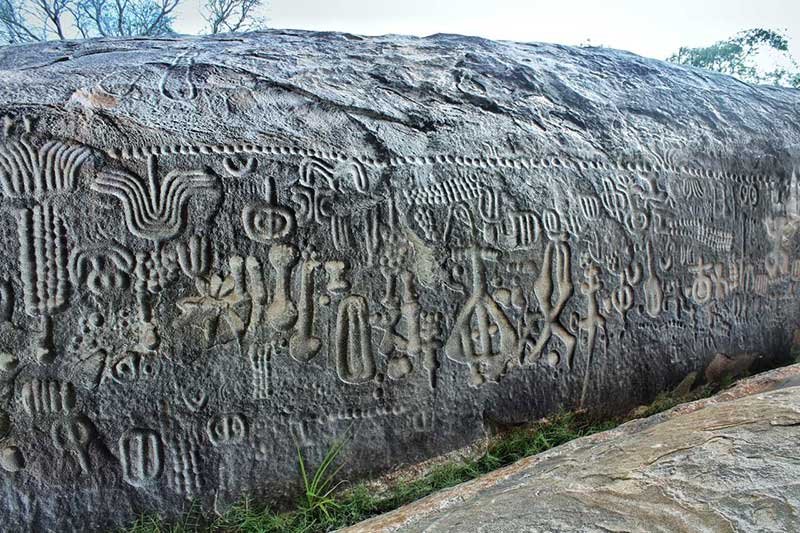The Ingá Stone, or Itacoatiara do Ingá, as it’s locally known, is one of Brazil’s most fascinating archaeological sites. Located near the city of Ingá, Paraíba, in northeastern Brazil, it stands majestically on the banks of the Ingá River. The stone takes its name from the Tupi language, where “Itacoatiara” translates to “stone,” reflecting the indigenous roots that once thrived in the area.
The Ingá Stone is a prehistoric rock formation composed primarily of gneiss and measures approximately 250 feet in length and 6.5 feet in height. What makes the Ingá Stone particularly intriguing, however, is the elaborate and intricate set of carvings adorning its surface. These markings, etched into the hard surface of the stone, comprise a complex set of symbols, figures, and patterns that have mystified archaeologists and researchers for years. These carvings are believed to date back between 6,000 and 2,000 years, suggesting that they were created by a civilization predating any of the known indigenous tribes in the region (1).
The intricate carvings found on the stone display an array of motifs, including geometric patterns, zoomorphic figures (those resembling or representing animals), and possibly even celestial maps. There are images that look like birds, felines, humans, and other undetermined creatures. There are also suggestions of fruit, honeycombs, and even scenes that seem to represent a narrative (2).
The mysterious carvings on the Ingá Stone have drawn scholars and researchers from various fields and given rise to several intriguing theories. However, no definitive interpretation has been universally accepted due to the complex nature of the symbols, their possible multilayered meanings, and the absence of supporting contextual artifacts or texts. Here are a few of the most prominent theories that have been proposed to explain the enigmatic carvings:
- Astronomical Events: Some scholars believe that the carvings depict celestial bodies and events. For instance, it’s been suggested that some symbols resemble constellations and celestial phenomena. Some carvings, looking like concentric circles, could represent solar or lunar eclipses. This theory ties in with the global pattern of ancient civilizations using megaliths as astronomical observatories (1).
- Religious Symbols: Another theory proposes that the carvings are religious or spiritual symbols, possibly representing deities, spirits, or mystical creatures. They could have been used in rituals or ceremonies by the ancient peoples of the area. The presence of zoomorphic and anthropomorphic figures strengthens this theory (2).
- Historical Records: Some believe the carvings could be a form of historical record or narrative. They could represent significant events, battles, migrations, or changes in the environment that occurred in the community’s history. Some scenes on the stone seem to depict narratives, although their precise meanings remain unknown (3).
- Symbolic Language or Code: There is also a theory that the carvings represent a form of symbolic language or code, and the stone serves as a kind of prehistoric ‘book’. However, this ‘language’ has yet to be deciphered, and its complexity suggests a highly developed culture that contradicts current knowledge about prehistoric societies in the area (4).
- Extraterrestrial Influence: Finally, although largely considered fringe or pseudoscientific, there are theories proposing that the carvings could be the work of extraterrestrial beings. Supporters of this idea argue that the complexity and precision of the figures, as well as their potential representation of celestial events, hint at a knowledge level beyond what would have been possible for ancient indigenous cultures (5).
Despite the range of these theories, the true origins and meanings of the Ingá Stone carvings remain a mystery. Their interpretation is likely to remain an ongoing subject of research and debate among archaeologists, historians, and scholars from various fields for many years to come.
What is certain, though, is that the Ingá Stone is an invaluable piece of the region’s cultural and historical heritage. It continues to attract attention from tourists and researchers alike, who are drawn to its mystery and the possibility of unlocking the secrets it holds about the past.
References:
- Barreto, Cristiana; Fast, Danna (2016). “The Ingá Megalithic Site”. Archaeological Guide to Brazil. Belo Horizonte: Editora UFMG. pp. 247–250.
- Prous, André (1992). “Arqueologia Brasileira”. Universidade de Brasília.
- Netto, B. P. (1996). “Interpretações da Itacoatiara do Ingá: imagens da pré-história do nordeste do Brasil”. Revista UFPB, 11 (1-2), 9-29.
- Ruggles, C.L.N. (2005). Ancient Astronomy: An Encyclopedia of Cosmologies and Myth. ABC-CLIO.
- Eliade, Mircea (1959). The Sacred and The Profane: The Nature of Religion. New York: Harcourt, Brace.
- Renfrew, C., & Bahn, P. (2008). Archaeology: Theories, methods and practice (5th ed.). London: Thames & Hudson.
- Mallery, Garrick, (1893). Picture-writing of the American Indians, New York: Dover Publications.
- von Däniken, Erich. (1968). Chariots of the Gods? Unsolved Mysteries of the Past. Bantam Books.
